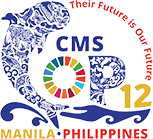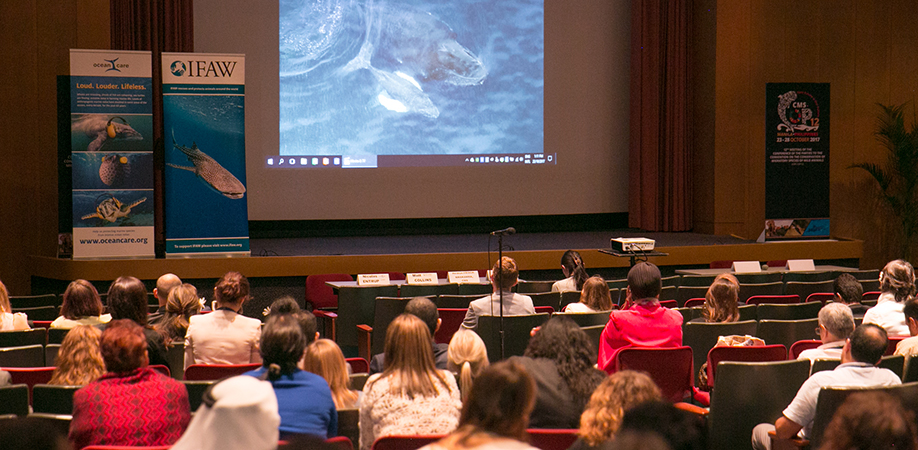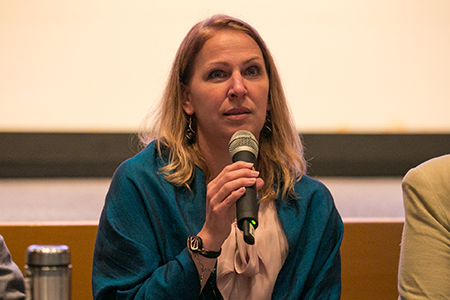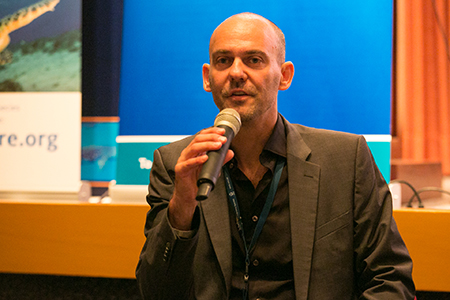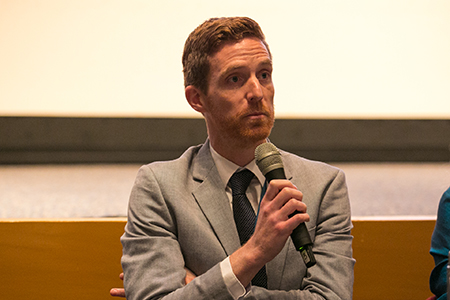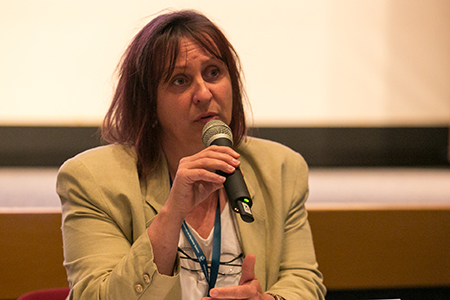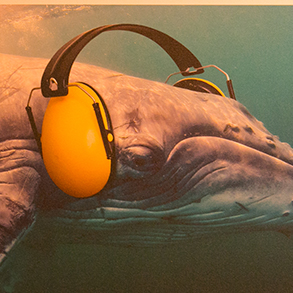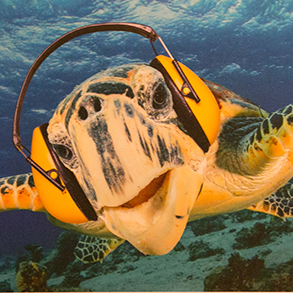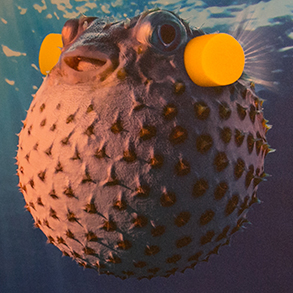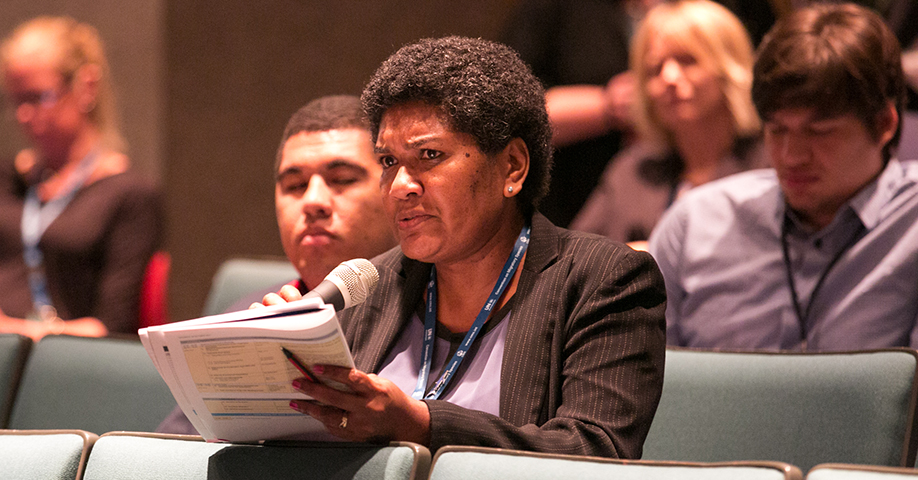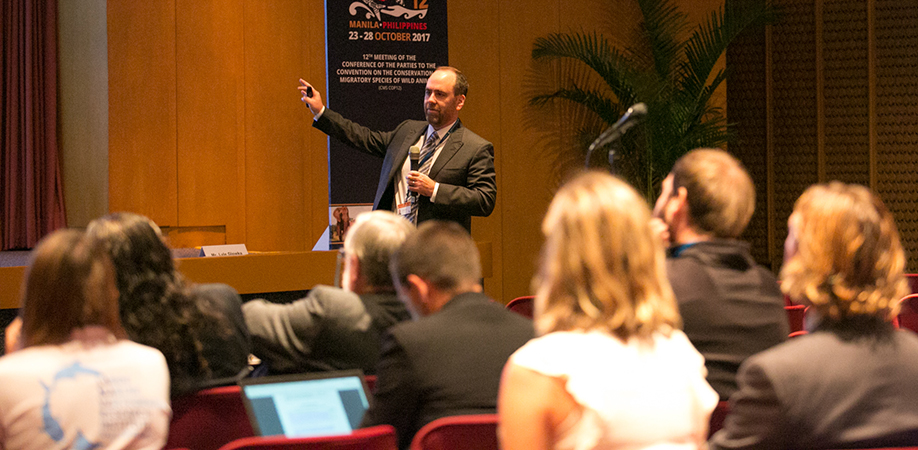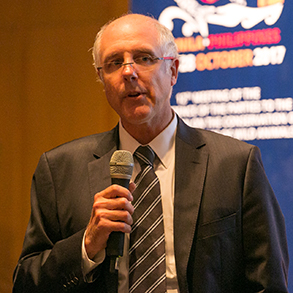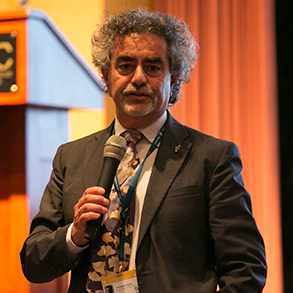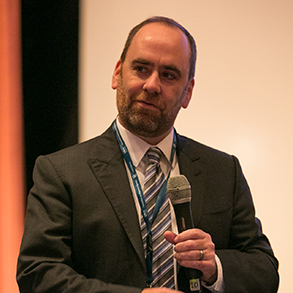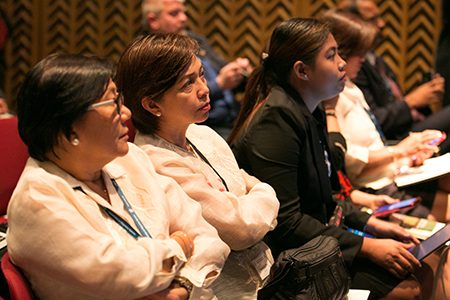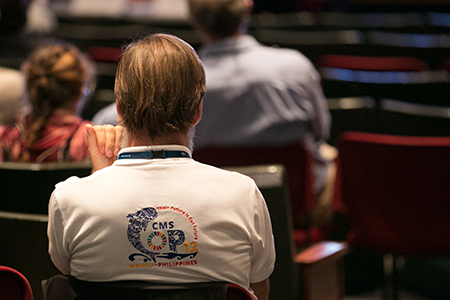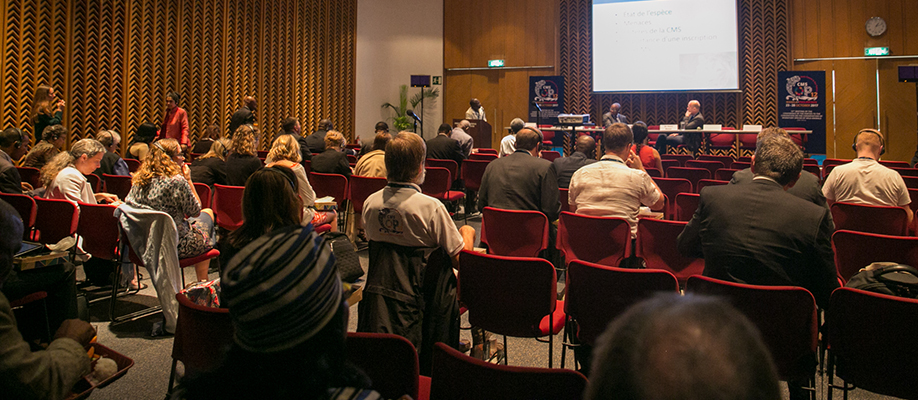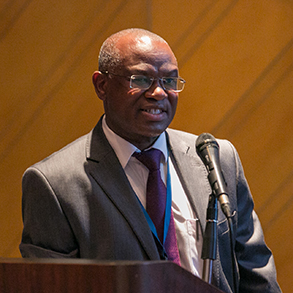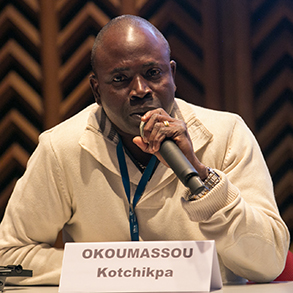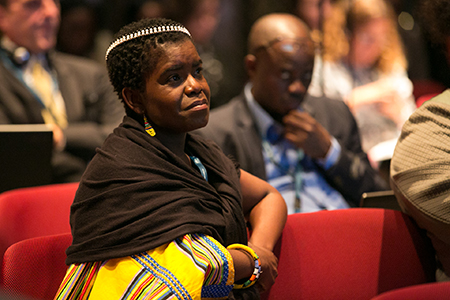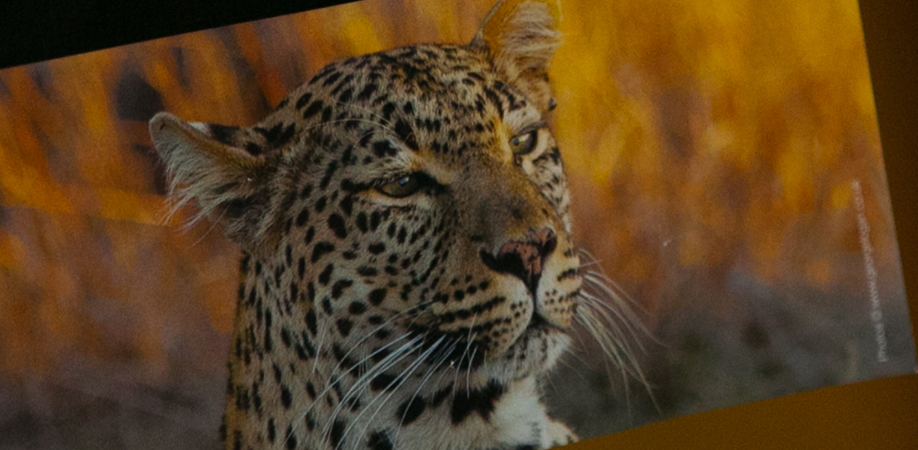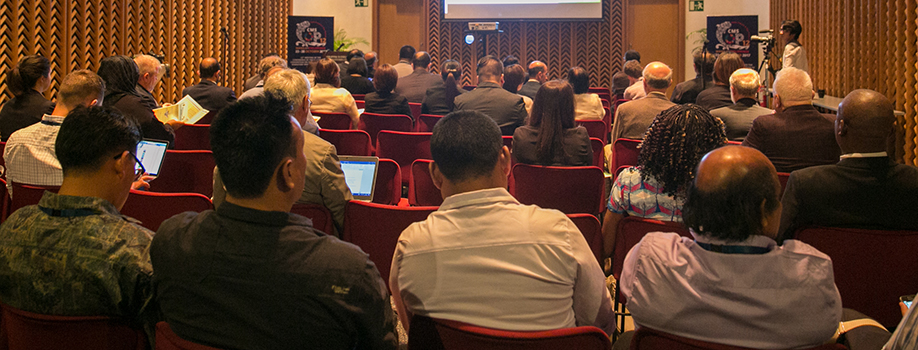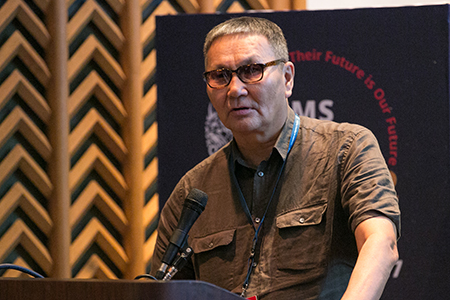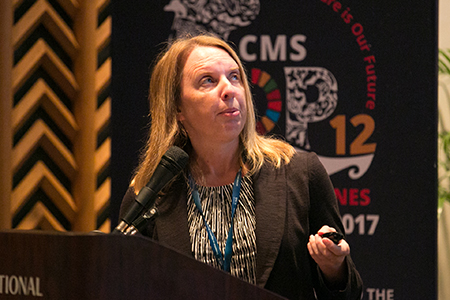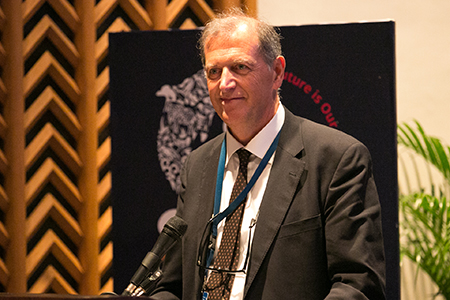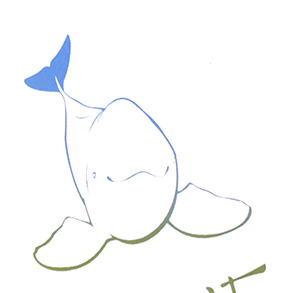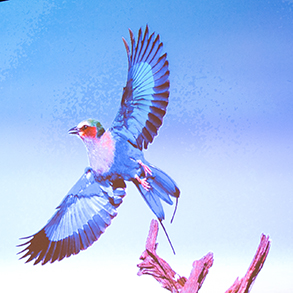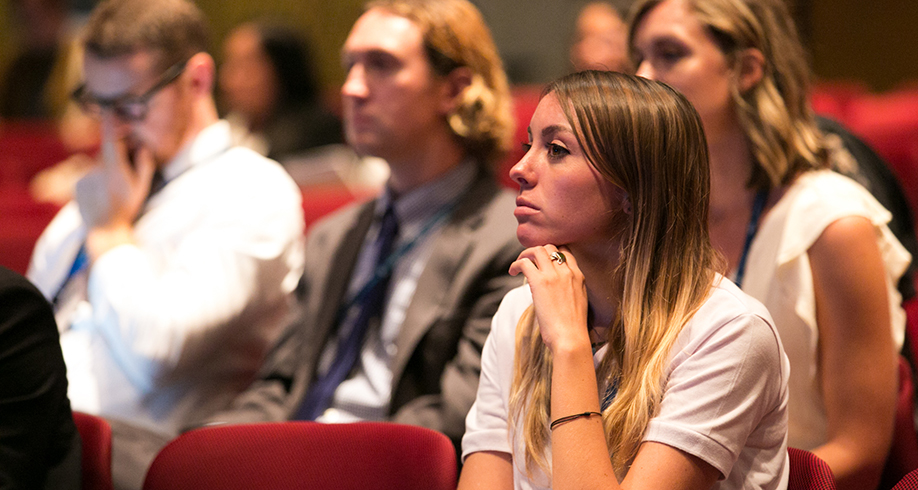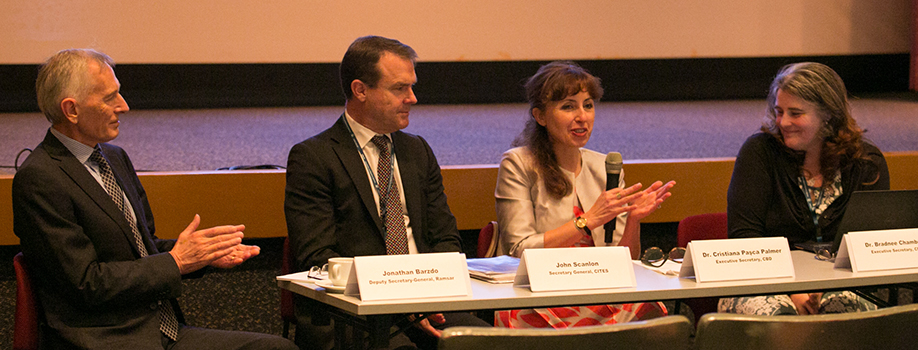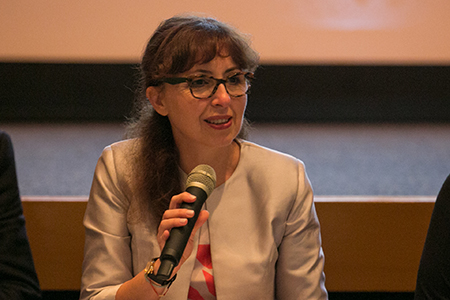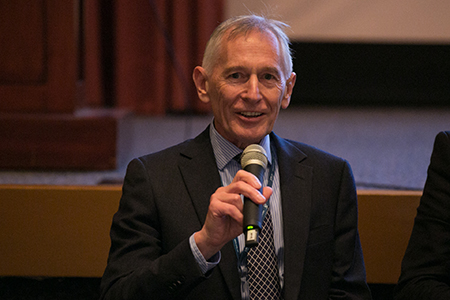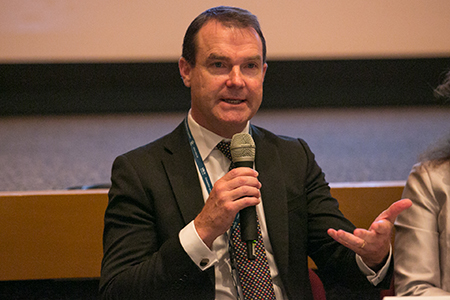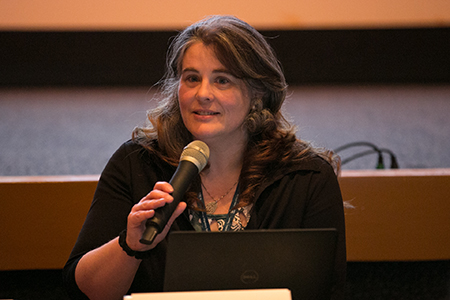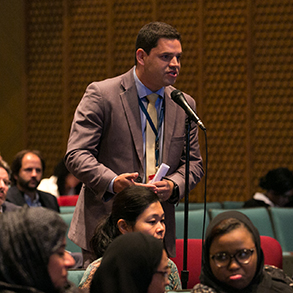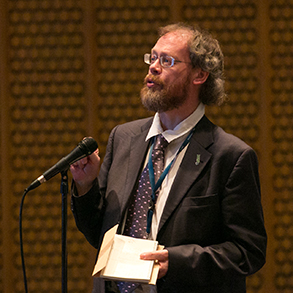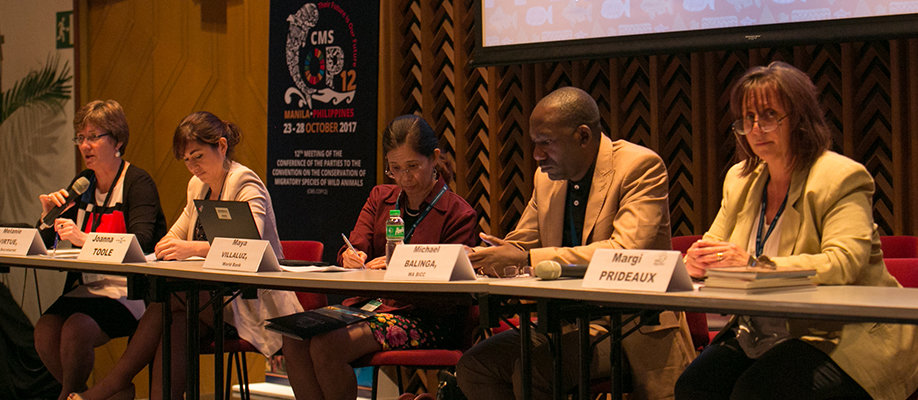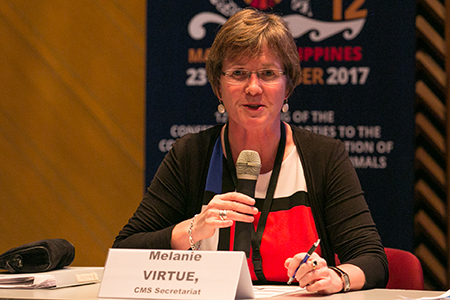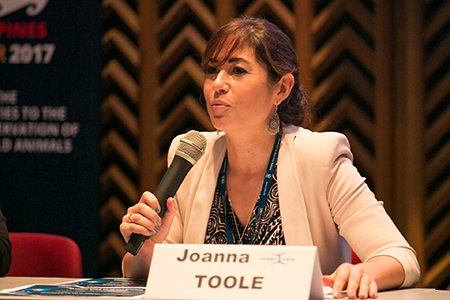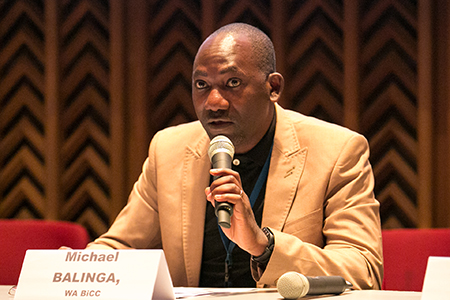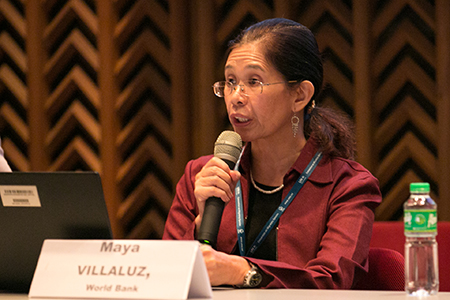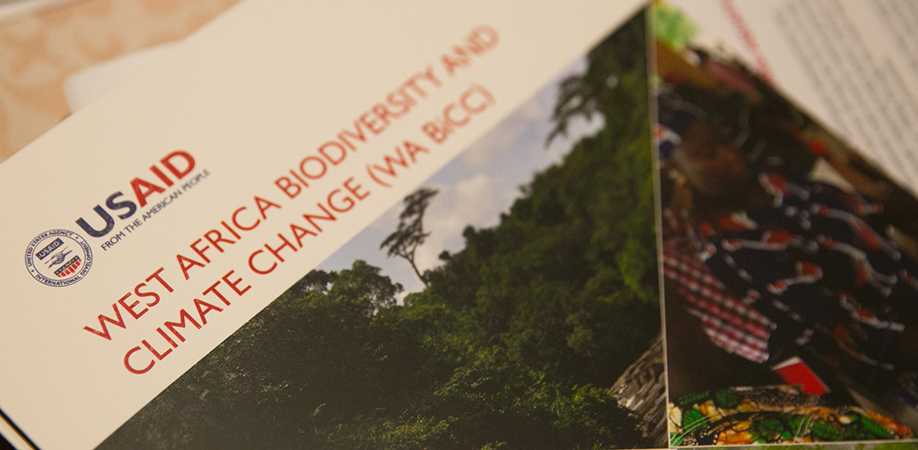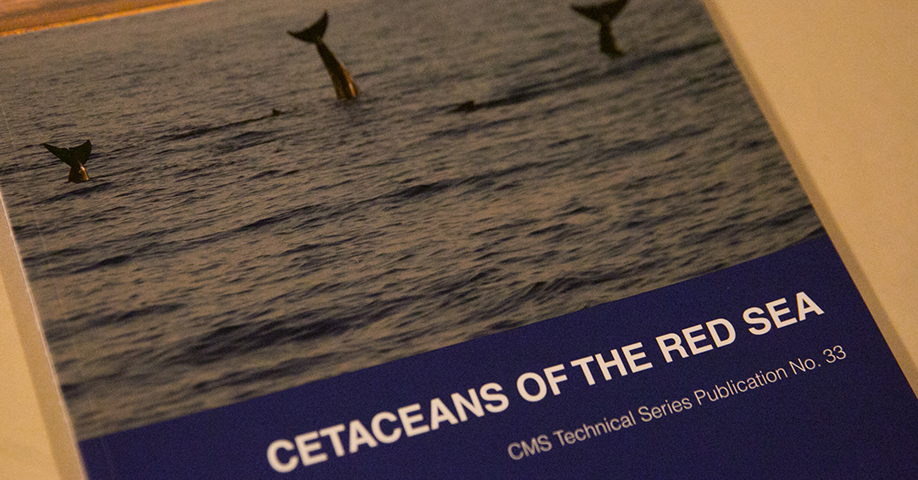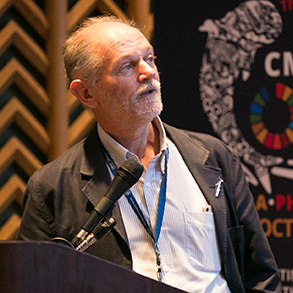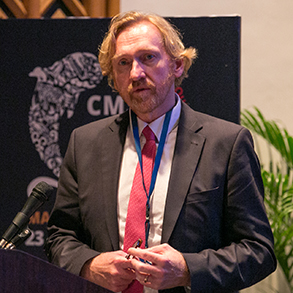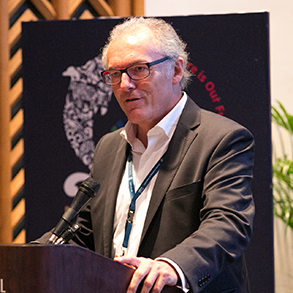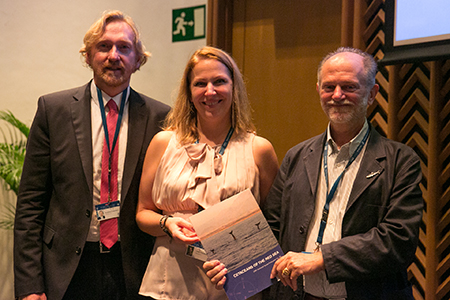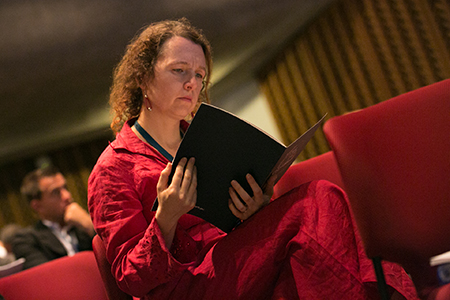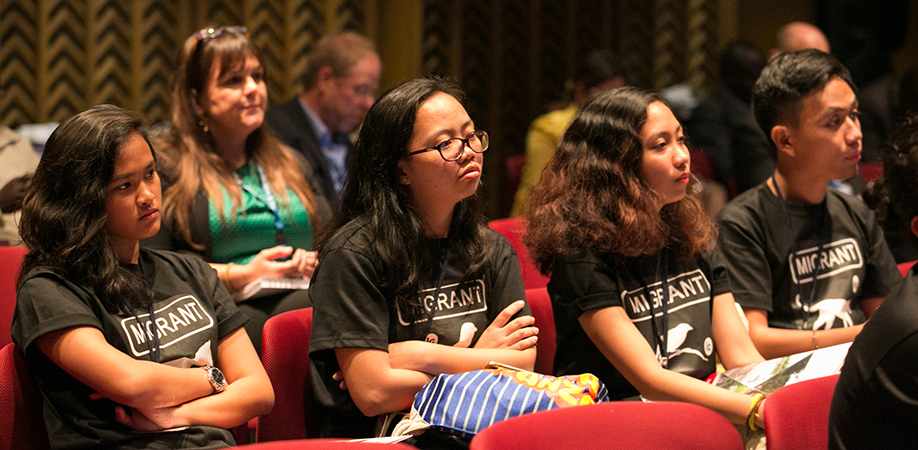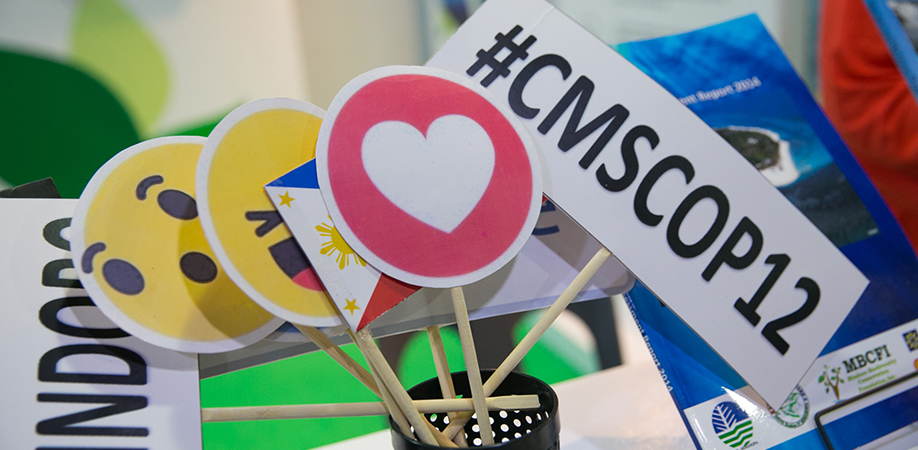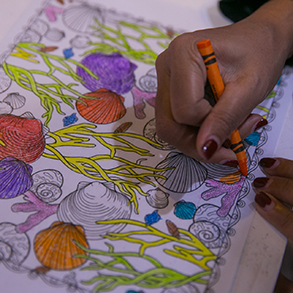Summary
The following events were covered by IISD Reporting Services on Monday, 23 October 2017:
- Marine Noise – Turning Down the Volume for Marine Life
- Development of a New System to Describe Migratory Connectivity in the Ocean (MiCO)
- Lion and Leopard Listing Proposals and Role of CMS in African Carnivore Conservation
- The Conservation of Migratory Species along “the Belt and Road”: a Case Study of the Great Bustard
- Follow-up to the Strategic Plan for Biodiversity beyond 2020
- The West African Abidjan Aquatic Wildlife Partnership
- Cetaceans of the Red Sea: Launch of New Report
IISD Reporting Services, through its Earth Negotiations Bulletin on the Side (ENBOTS) Meeting Coverage, is providing daily web coverage from selected side events at CMS COP12.
Photos by IISD/ENB | Kiara Worth
For photo reprint permissions, please follow instructions at our Attribution Regulations for Meeting Photo Usage Page.
Marine Noise – Turning Down the Volume for Marine LifePresented by the OceanCare, Natural Resources Defense Council (NRDC), and the International Fund for Animal Welfare (IFAW)
This event, moderated by Nicolas Entrup, OceanCare, centered on: the growing marine noise pollution caused by human activities and its impact on whales and other marine animals; marine noise as a transboundary issue; and the need to empower governments with guidelines for robust Environmental Impact Assessments (EIAs) prior to approving noise-generating activities in the marine environment.
The session started with a film, ‘Sonic Sea,’ on the critical role of sound in the sea. The video highlighted impacts that commercial and military ships have on acoustic habitat, which threaten the ability of whales and other marine animals to prosper, function, and survive. The video suggested potential solutions to reduce marine noise, including research on alternative technologies to underwater explosions conducted by military ships.
Matt Collis, IFAW, said that marine noise affects not only marine mammals, but also commercial fish species, and stressed that viewing marine noise as a pollutant could make this issue more visible in the political arena.
Heidrun Frisch-Nwakanma, CMS, emphasized the importance of an assessment tool on marine activities. He outlined the proposed resolution on the EIA guidelines, which provides a list of criteria for governments to assess commercial marine activities.
Margi Prideaux, Wild Migration, explained that policies on marine protected areas (MPAs) are an important instrument to deal with human activities affecting migratory species, and urged governments to utilize the proposed EIA guidelines to reduce marine noise pollution.
In the ensuing discussion, participants discussed the need for understanding marine noise as a “transboundary impact” on many industrial marine areas, and called for CMS COP12 discussions to consider long-term solutions rather than rely on MPA policies, including through reforming design of ship engines, and using the EIA guidelines as a “toolkit” for assessing marine activities.
Participants watch a video discussing the challenge of marine noise
Heidrun Frisch-Nwakanma, CMS, stressed that marine noise is a transboundary issue, noting that “local communities alone cannot solve the issue.”
Nicolas Entrup, OceanCare, called for CMS decisions to focus on providing actions rather than paper resolutions.
Matt Collis, IFAW, described major impacts of marine noise on migratory species and acoustic habitat.
Margi Prideaux, Wild Migration, highlighted the proposed EIA guidelines as an “information source for governments.”
Participants ask questions during the event
Contact:
-
Nicolas Entrup (OceanCare) | nentrup@oceancare.org
Matt Collis (IFAW) | mcollis@ifaw.org
More Information:
Development of a New System to Describe Migratory Connectivity in the Ocean (MiCO)Presented by the Global Ocean Biodiversity Initiative (GOBI), Duke University, and CMS
This session, moderated by Lyle Glowka, CMS, explored the need for, and progress in, developing a system to aggregate and make migratory connectivity data accessible, for use in area-based management and marine spatial planning (MSP) within and beyond national jurisdiction.
Fernando Spina, Chair, CMS Scientific Council, said clarifying connectivity in the open ocean would be an amazing result for many highly endangered and iconic species.
Daniel Dunn, Duke University, presented on collaborative efforts to aggregate and synthesize information on migratory connectivity. He described elements of the MiCO project, including a literature review of 208 marine species using data from telemetry, mark recapture and stable isotopes, passive acoustic monitoring, and genetic sampling. He projected roll-out of the tool by Convention on Biological Diversity COP13.
Giuseppe Notarbartolo di Sciara, Tethys Research Institute, CMS Councillor for Aquatic Mammals, highlighted the challenges of studying migration of marine animals, including the need to rely on “inherently biased” information, such as fisheries data.
Participants attend the event
Lyle Glowka, CMS, highlighted the link between migratory species and ecologically or biologically significant marine areas (EBSAs).
Fernando Spina, Chair, CMS Scientific Council, called CMS the “connectivity convention,” as a model for building shared responsibility across nations.
Daniel Dunn, Duke University, said data warehouses lack “maps of connectivity” and EBSA processes have gaps "because they are limited to the experts in the room."
Participants during the event
Contact:
-
Daniel Dunn (Coordinator) | daniel.dunn@duke.edu
More Information:
Lion and Leopard Listing Proposals and Role of CMS in African Carnivore ConservationPresented by the Governments of Togo and Kenya
This event addressed the proposals by several countries to include the lion and leopard in the CMS appendices, covering the species’ decline, range and benefits to listing.
Kotchikpa Okoumassou, Ministry of Environment, Togo, presented the proposal by Togo, Chad, Niger and other West African countries to include the lion in the CMS Appendices, noting that lion populations in Africa have declined by 43% between 1993 and 2014 and are in danger of extinction in most of their range states. He said threats include indiscriminate killing, poorly managed hunting, diminishing prey, and inaction to conserve the lion. He emphasized that listing the lion satisfies CMS criteria.
Samuel Kasiki, Kenya Wildlife Service, presented the proposal by Ghana, Iran, Kenya, and Saudi Arabia to include the leopard in the CMS Appendix II. He said there has been a 61% range reduction from 2008 to 2016 due to, inter alia, human/wildlife conflicts, habitat fragmentation and illegal trade. He stressed that the free migration of leopards is crucial for their survival, noting that more “international cooperation agreements for conservation” are needed. He also emphasized that the proposal meets CMS criteria and that its adoption would help enable CMS to coordinate international leopard conservation through cooperation and increasing global awareness.
Hans Bauer, Oxford University, noted that the CMS can address three causes associated with the decrease in lions populations: prey depletion, human/lion conflicts, and habitat loss. On leopards, he noted potential for transboundary management, and that CMS Appendix II listing would have positive effects for a global leopard conservation strategy. He said CMS can facilitate strategies for implementation, develop action plans, and provide financial and institutional support.
Discussion centered on support and concerns for the listings, including: increased regional cooperation; creating a census of populations; and the implementation of existing initiatives and protocols.
View of the room during the event
Samuel Kasiki, Kenya Wildlife Service, said that leopards migrate seasonally in search of prey, making population connectivity crucial for their survival.
Kotchikpa Okoumassou, Ministry of Environment, Togo, requested support for including lions and leopards in the CMS Appendix II to help ensure the future of these iconic species.
Hans Bauer, Oxford University, noted that a significant proportion of lions and leopards “cyclically and predictably” cross national borders, making them relevant to the CMS context.
Participants during the event
Contact:
-
Kotchikpa Okoumassou | okoumassoukotchikpa@yahoo.fr
The Conservation of Migratory Species along “the Belt and Road”: a Case Study of the Great BustardPresented by the China Biodiversity Conservation and Green Development Foundation (CBCGDF)
This side event, moderated by Shuya Huang, CBCGDF, addressed the conservation of migratory bird species in Asia, using the Great Bustard as a case study.
Borja Heredia, CMS, underscored that environmental concerns need to go hand in hand with infrastructure development, taking into account environmental impact assessments (EIAs) and thus minimizing adverse impacts. He highlighted that CMS has signed a memorandum of cooperation with CBCGDF, looking forward to working with countries in the region, including China, as CMS parties.
Presenting on the role of CBCGDF on the conservation of the Great Bustard in China, Frederick Dubee, CBCGDF, noted that the foundation’s priority areas include the Community Conservation Area for something at somewhere (CCAfa) system, sustainable wildlife management, endangered species conservation, environmental public interest litigation (EPIL), wildlife volunteer networks and the Ecological Belt and Road initiative.
Mimi Kessler, Eurasian Bustard Alliance, underscored that main threats for Great Bustards include: poaching for sport and food; poisoning, both accidental and for meat sale; and collision with power lines, intensified by low reproduction rates that are further lowered by agricultural intensification. She highlighted the need to: improve conditions across the migratory range; coordinate conservation activities and surveys; stimulate more research on movement patterns, important habitats and conflicts with cabling; and promote international exchange between range states and successful conservation initiatives.
Focusing on the Mongolian efforts for the conservation of Great Bustards, Lkhagvasuren Badamjav, Mongolia, noted attitudes are changing regarding the conservation of Great Bustards due to campaigns on the uniqueness and importance of the species, and highlighted his country’s proposal for a concerted action plan to be adopted by CMS COP12.
A video presentation entitled ‘Bird Guards’ by Song Keming, CCAfa, addressed the efforts to protect birds in the region from poison baits and other threats. Noting that images have power, Kevin Zou, EPNF, discussed ways to protect wildlife through photography and invited participants to visit the ‘Beyond Eyes, International Nature Image Festival’ photography exhibition on display at the venue.
View of the room during the event
Frederick Dubee, CBCGDF, highlighted education, empowerment and collaboration as the main CBCGDF pillars.
Lkhagvasuren Badamjav, Mongolia, urged for the proposed Concerted Action for the Asian Great Bustard, jointly submitted by the Government of Mongolia, the Eurasian Bustard Alliance and the Wildlife Research and Conservation Center of Mongolia, to be adopted by COP12.
Noting that there is a lot of missing data, Mimi Kessler, Eurasian Bustard Alliance, underscored the need for international cooperation to address transboundary movements and connect the dots between breeding and wintering grounds.
Borja Heredia, CMS, discussed the need to address environmental impacts when developing infrastructure.
Images of wildlife used to promote understanding and conservation
Participants during the event
Contact:
-
Shuya Huang (moderator) | hsy@cbcgdf
More Information:
Follow-up to the Strategic Plan for Biodiversity beyond 2020Presented by the Convention on Biological Diversity (CBD), CMS, Ramsar Convention, and the Convention on International Trade in Endangered Species of Wild Fauna and Flora (CITES)
This session, moderated by Cristiana Paşca Palmer, Executive Secretary, CBD, centered on the preparation process of the follow-up to the Strategic Plan for Biodiversity beyond 2020, and the efforts made by the secretariats of respective biodiversity conventions to align and synergize in terms of respective strategic plans and actions.
Cristiana Paşca Palmer, Executive Secretary, CBD, reviewed the current status of the post-2020 Strategic Plan for Biodiversity, and stressed that the process is an opportunity for synergies among different conventions and other policy arenas, including those on climate change and the Sustainable Development Goals (SDGs). She explained how the post-2020 Strategic Plan on Biodiversity builds on the current plan, using the Aichi Targets as a starting point.
Ines Verleye, CMS, presented the Strategic Plan for Migratory Species (SPMS) 2015-2023, adopted in CMS COP11, and explained that the SPMS indicators will be adopted at CMS COP12. She emphasized the plan puts CMS commitments into broader political commitments, and said SPMS indicators are “migratory species cut” of biodiversity indicators, to evaluate progress on implementation of CMS as well as the Aichi Targets.
John Scanlon, Secretary General, CITES, highlighted the CITES Secretariat’s active engagement in the preparation process of the post-2020 Strategic Plan for Biodiversity. He stressed the importance of collaborative and positive coordination made so far among respective secretariats of biodiversity conventions, and allying these efforts with the SDGs implementation.
Jonathan Barzdo, Deputy Secretary General, Ramsar Convention, explained that the Parties to the Ramsar Convention decided to review its current Strategic Plan by the end of 2019 and consider alignment with three instruments: the 2030 Agenda for Sustainable Development including the SDGs; the work of the Intergovernmental Science-Policy Platform on Biodiversity and Ecosystem Services (IPBES); and the post-2020 Strategic Plan for Biodiversity. He stressed the current efforts to create synergies among different biodiversity conventions are useful to report progress on biodiversity conventions as well as on the SDGs.
In the ensuing discussion, participants discussed, inter alia: the need for better coordination at all levels, including among respective secretariats, national focal points and relevant ministries; and developing specific and measurable indicators for the respective Strategic Plans.
View of the panel (L-R): Jonathan Barzdo, Deputy Secretary General, Ramsar Convention; John Scanlon, Secretary General, CITES; Cristiana Paşca Palmer, Executive Secretary, CBD; and Ines Verleye, CMS.
Cristiana Paşca Palmer, Executive Secretary, CBD, highlighted the need for collectively raising a profile of biodiversity agenda.
Jonathan Barzdo, Deputy Secretary General, Ramsar Convention, emphasized that “participating in this coordination process” is an important starting point.
John Scanlon, Secretary General, CITES, said secretariats needs to work together in implementing the SDGs and “we are on board.”
Ines Verleye, CMS, stressed the importance of improving information sharing mechanisms among different biodiversity conventions.
Participants engage in an interactive discussion
Contact:
-
Robert Höft (CBD Secretariat) | robert.hoft@cbd.int
More Information:
The West African Abidjan Aquatic Wildlife PartnershipPresented by OceanCare, West Africa Biodiversity and Climate Change (WA BiCC) Program and Wild Migration
This event, moderated by Joanna Toole, OceanCare, focused on the new Abidjan Aquatic Wildlife Partnership, which addresses the issue of illegal and unregulated killing, trade and consumption of aquatic wildlife in West and Central Africa.
Melanie Virtue, CMS, presented efforts to conserve aquatic mammals, highlighting, inter alia, the initiative with BirdLife International on bycatch. She said that the CMS Secretariat wants to engage with West Africa to help implement similar partnerships.
Joanna Toole, representing the Abidjan Secretariat, explained the history of the Abidjan Convention, which provides coordination for all marine-related programmes in the region, and the emergence of the Abidjan Partnership. She stressed that without it the issue would “fall through the cracks of international conventions and governments, because it has no clear home.”
Maya Villaluz, World Bank, presented initiatives on the “blue economy” and said the World Bank is working with the Abidjan Secretariat and OceanCare to define the Partnership and build a bridge between fisheries policies and the environmental protection agenda.
Michael Balinga, WA BiCC Programme, presented a draft scoping report on aquatic endangered, threatened and protected (ETP) species, and said possible actions and interventions should include an increase in the aquatic ETP knowledge base and capacity building for law enforcement.
Margi Prideaux, representing the Chair of the Aquatic Mammals Working Group, said the Abidjan Partnership is directly relevant to the CMS COP, because a new thematic Working Group on Wild Meat has been proposed, which can directly support the Partnership.
Joanna Toole, representing OceanCare, reported on current progress on the Abidjan Wildlife Partnership, captured in a published partnership document.
View of the panel (L-R): Melanie Virtue, CMS; Joanna Toole, OceanCare; Maya Villaluz, World Bank; Michael Balinga, WA BiCC; and Margi Prideaux, representing the Chair of the Aquatic Mammals Working Group
Melanie Virtue, CMS, said there are multiple CMS Memoranda of Understanding, but not enough funds to implement them properly. Partnerships like this help with implementation.
Joanna Toole, OceanCare, representing the Abidjan Secretariat, said that the issue of aquatic wild meat is a global issue, but it is particularly acute in the West and Central African region, and welcomed the proposal to develop a Working Group focused on Aquatic World Meat.
Michael Balinga, WA BiCC, said that through carrying out a scoping report on aquatic ETP species, they have “started to see the links between CMS- and CITES-listed species that need to be conserved in West Africa.”
Maya Villaluz, World Bank, said she was looking forward to seeing how “the delivery of the Abidjan Partnership can be bigger than the sum of its individual pieces.”
Contact:
-
Joanna Toole | jtoole@oceancare.org
More Information:
Cetaceans of the Red Sea: Launch of New ReportPresented by the CMS Secretariat
This side event focused on the launch of a new report on the Cetaceans of the Red Sea as part of the CMS technical series.
Thierry Touchais, GoodPlanet Foundation, stressed the critical role of observation for making scientifically-based, conservation-related decisions that portray reality. He highlighted participatory science, underscoring cooperation between the scientific and non-scientific world, and underscored that the new report contains both historic data and current observations.
Presenting the report, Guiseppe Notarbartolo di Sciara, Tethys Research Institute, Marine Mammal Protected Areas Task Force, noted that the Red Sea is one of the least studied regions, with extremely scant knowledge of marine mammal presence and often anecdotal information. He highlighted pressures from human activities, despite extremely low human population density, including shipping, oil extraction and transportation, tourism, fishing and climate change. He then focused on the diversity of Red Sea cetaceans, which include: Baleen whales, namely Bryde’s whale, Omura’s whale and humpback whale; regular odontocetes, comprising false killer whales as well as Risso’s, Indian Ocean humpback, Indo-Pacific common, Indo-Pacific bottlenose, common bottlenose, pantropical spotted and spinner dolphins; and rare odontocetes, namely the dwarf sperm whale, orca or killer whale, the short-finned pilot whale, the rough toothed dolphin and the striped dolphin.
Bradnee Chambers, Executive Secretary, CMS, expressed his satisfaction for publishing the report as part of the Convention’s technical series, stressing that solid scientific data are invaluable for effective conservation efforts and for strengthening relevant policies.
In the ensuing discussion, participants addressed, inter alia: anthropogenic pressures on cetaceans in the Red Sea; the potential to extend the policies of the Agreement on the Conservation of Cetaceans of the Black Sea, Mediterranean Sea and contiguous Atlantic area (ACCOBAMS) in the Red Sea; and ways to encourage range states to work together, initiating a process to protect cetaceans in the region.
The newly launched report 'Cetaceans of the Red Sea'
Guiseppe Notarbartolo di Sciara, Tethys Research Institute, Marine Mammal Protected Areas Task Force, provided a panorama of the diversity of Red Sea cetaceans, resulting from scientific work that lasted several decades.
Highlighting the importance of scientific data to shape relevant policy decisions, Bradnee Chambers, Executive Secretary, CMS, stressed that cetaceans in the Red Sea are under pressure due to inter alia, climate change, chemical pollution, noise pollution, and direct killing.
Thierry Touchais, GoodPlanet Foundation, stressed that reports such as ‘Cetaceans in the Red Sea’ raise awareness necessary for conservation action.
Bradnee Chambers, CMS Executive Secretary; Heidrum Frisch-Nwakanma, CMS; and Guiseppe Notarbartolo di Sciara, Tethys Research Institute, Marine Mammal Protected Areas Task Force, launch the new report on the Red Sea Cetaceans
Sophie Mirgaux, EU, reads the new report
Participants during the event
Contact:
-
Guiseppe Notarbartolo di Sciara | disciara@gmail.com
More Information:
Around the Venue
Around the CMS COP12 venue
